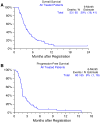Phase II trial of vatalanib in patients with advanced or metastatic pancreatic adenocarcinoma after first-line gemcitabine therapy (PCRT O4-001)
- PMID: 24939212
- PMCID: PMC4461053
- DOI: 10.1007/s00280-014-2499-4
Phase II trial of vatalanib in patients with advanced or metastatic pancreatic adenocarcinoma after first-line gemcitabine therapy (PCRT O4-001)
Abstract
Purpose: Vatalanib (PTK 787/ZK22584) is an oral poly-tyrosine kinase inhibitor with strong affinity for platelet-derived growth factor and vascular endothelial growth factor (VEGF) receptors. We conducted an open-label, phase II multicenter therapeutic trial investigating the efficacy and tolerability of vatalanib in patients with metastatic or advanced pancreatic cancer who failed first-line gemcitabine-based therapy.
Methods: Vatalanib treatment consisted of a twice daily oral dosing using a "ramp-up schedule," beginning with 250 mg bid during week 1,500 mg bid during week 2, and 750 mg bid on week three and thereafter. The primary objective of this study was to evaluate the 6-month survival rate.
Results: Sixty-seven patients were enrolled. The median age was 64, and 66% (N = 43) had only one prior regimen. Common grade 3/4 adverse events included hypertension (20%; N = 13), fatigue (17%; N = 11), abdominal pain (17%; N = 11), and elevated alkaline phosphatase (15%; N = 10). Among the 65 evaluable patients, the 6-month survival rate was 29% (95% CI 18-41%) and the median progression-free survival was 2 months. Fifteen patients survived 6 months or more. Two patients had objective partial responses, and 28% of patients had stable disease. Changes in biomarkers including soluble VEGF and vascular endothelial growth factor receptor did not correlate with response to drug.
Conclusion: Vatalanib was well tolerated as a second-line therapy and resulted in favorable 6-month survival rate in patients with metastatic pancreatic cancer, compared with historic controls.
Conflict of interest statement
Figures




References
-
- Siegel R, Naishadham D, Jemal A. Cancer statistics, 2013. CA Cancer J Clin. 2013;63(1):11–30. - PubMed
-
- Warshaw AL, Lillemoe KD, Castillo CF. Pancreatic surgery for adenocarcinoma. Curr Opin Gastroenterol. 2012;28(5):488–493. - PubMed
-
- Conroy T, et al. FOLFIRINOX versus gemcitabine for metastatic pancreatic cancer. N Engl J Med. 2011;364(19):1817–1825. - PubMed
-
- Campen CJ, Dragovich T, Baker AF. Management strategies in pancreatic cancer. Am J Health Syst Pharm. 2011;68(7):573–584. - PubMed
Publication types
MeSH terms
Substances
Grants and funding
LinkOut - more resources
Full Text Sources
Other Literature Sources
Medical

